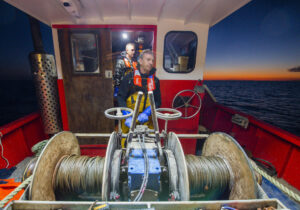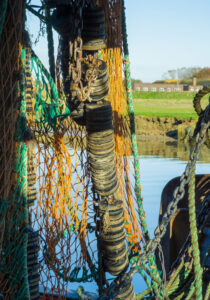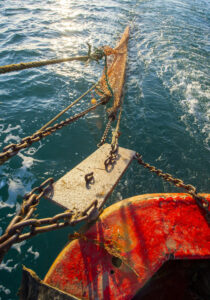Rye’s bespoke fishing quay has made this south coast town the perfect base for a father and son team who use a triple-rig trawl to target flatfish, reports John Periam. Photographs by Geoffrey Lee
Rye in East Sussex has a small and tight-knit fishing community. Below the town on the Rother estuary is Simmons Quay, which was opened 16 years ago, making it one of the newest purpose-built quays on the south coast. It is rightly named after local fisherman and fishermen’s representative Ronnie Simmons BEM, who was the driving force behind the project.

01. My Sara towing the triple-rig trawl in Rye Bay.

02. Mark Ball shoots the trawl for the first tow of the day.

03. The drum brakes are applied when the selected length of wire reaches the hanging blocks.

04. Mark prepares to release the codend on the starboard net.

05. Rye-based fishing boats moored at Simmons Quay, with My Sara in the foreground.

06. Jamie prepares the nets for the day’s fishing.

07. The ground ropes of the trawls are made up with 3in-diameter rubber discs on 8mm-diameter chain and 8mm chain droppers.

08. The triple-rig trawl system. (Courtesy of Seafish Gear Database)

09. Mark installs the replacement starter motor on the Gardner 6LXB engine.

10. Shooting the nets for the first tow…

11. … and checking that the nets and ropes have shot cleanly.

12. The splits are connected by 10mm chain to steel sledges on the wing ends of the middle and outer trawls.

13. Lifting the last of the nets into the water.

14. A bird’s-eye view of the triple-rig trawl.
Simmons Quay has berths for 19 fishing boats, all equipped with winches, water and electricity, and a fuelling point. Ronnie Simmons oversees things from his little shed on the quay. Known as the ‘Hilton Hotel’, it serves as a meeting point for the fishermen.
Ronnie Simmons had set up for Fishing News to go to sea for a day with skipper Mark Ball and his son Jamie on My Sara RX 419.
The Ball family live in Hastings, and fished from there for many years – they still have a locker and winch on the beach there. Mark Ball said: “When I was at school, I always went down to the local beach, the Stade, which to this day has the largest fleet of beach-based fishing vessels in Europe. I used to help the fishermen bring their boats in over the steep shingle bank and unload their catches. I also did some fishing with a schoolmate in a small rowing boat with a few trammel-nets, before and after school.”
On leaving school at the age of 15, Mark took up fishing full-time, and he has now been fishing for 42 years. He said: “After I left school, I fished with my brother Robert for seven years, where I gained most of my experience. In 1985, I got my first vessel, a 21ft clinker-built wooden fishing boat, which I had for five years. Then I got a larger wooden beach boat from Dungeness, which I used for five years. However, the maintenance costs of wooden boats were often a worry.”
The time came for a change, and Mark decided to get a larger steel boat built, which he called My Sara. “When I got that, it was a lot heavier than the wooden boat, and hauling her up the beach became a lot harder as the tides changed the gradient of the shingle bank. People forget you need a powerful winch and also a bulldozer – we helped each other, but it was still an effort.
“Rye was just around the corner. I knew Ronnie and was impressed with the way he ran things there, and he offered me a berth. I gave it a try for six months, and here I am today, reflecting on one of the best moves I ever made.”
The steel hull of My Sara was built in 2001 by Eric Hammond of Offshore Steel Boats Ltd, based in Barton-Upon-Humber. Mark and his brother Robert built and fitted out the rest of the boat to their exact specifications, and the vessel was registered in 2002.
My Sara has main dimensions of LOA 9.95m and beam 3.90m, and a GT of 11.84t. The vessel is powered by a Gardner 6LXB engine of 97kW, coupled to a Self-Change gearbox of 3:1 reduction, a 2½in shaft and a 35in four-bladed bronze propeller, giving a cruising speed of 7-8 knots. During a 12-hour fishing trip, the engine uses approximately 160 litres of diesel.
During lockdown, Mark Ball had My Sara taken out of the water, when the vessel went through its five-year MCA inspection and was fully repainted. This included a change of hull colour from blue to red. Two berths have recently been installed below in the fore cabin.
The wheelhouse electronic equipment includes an Olex 3D seabed mapping system, Simrad CP44 and Standard Horizon CP180 colour GPS chart plotters, Koden CVS128 echosounder, Simrad AP35 autopilot, Simrad broadband touch-screen NSS EVO3 radar, Simrad RT64 marine VHF, Icom IC-M411 DSC VHF and Amec AIS system.
After waiting several weeks for a break in the weather, the XC Weather App was showing a fine day with a northerly 5-6mph wind – ideal conditions for Geoffrey Lee to be able to photograph Mark and Jamie safely.
They met up at 11.30am at Simmons Quay in order to catch the high tide. Mark’s aim was to do five or six tows that day, timing his return to catch the next high tide.
The day started with a full safety briefing and kit-out. Mark and Jamie use Mullion Compact 150 Mark 3 PFDs, supplied via Ocean Safety and Seafish. Mark then checked the oil levels on the engine and made ready to set out – whereupon the engine failed to start. Going below deck into the engine compartment, he established that the issue was probably the starter motor. Jamie was dispatched to Hastings to pick up a replacement starter motor that they kept for such a situation.
A couple of hours later, with the replacement starter motor fitted and tested, they left the quay and headed two miles south down the river Rother, passing the nature reserve on the way out of Rye harbour into the Channel. They then steamed six miles south of the harbour entrance at a steady 7.5 knots into Rye Bay, with Mark keeping a careful watch – the shipping lanes off Rye get busy, as can the harbour at times.
Meanwhile, Jamie set up the main deck so that the fish washer and boxes were all ready for sorting, sizing, cleaning and gutting. He then prepared the sole triple-rig nets, before the first tow commenced at 2.30pm.
Mark and Jamie Ball use a sole triple-rig to catch flatfish, primarily targeting Dover sole. The gear is worked from a Spencer Carter two-drum 1.5t trawl winch spooled with 80 fathoms of 12mm-diameter warps and 15 fathoms of 10mm-diameter splits. The hydraulics are driven off the fore end of the Gardner engine via a Fenner coupling.
The triple-rig gear consists of two six-fathom outer trawls and a seven-fathom middle trawl. The gear was shot in 15 fathoms of water, when 60 fathoms of wire followed the splits off the winch drums.
All four splits are connected by 10mm chain to two sledges on the wing ends of the middle and outer trawls. Made from 20mm steel plate, the sledges are 20in long by 8in wide.
A set of No. 3 Bison trawl doors is used to spread this arrangement of gear.
The ground ropes of the trawls are made up with 3in-diameter rubber discs on 8mm-diameter chain. Similar-sized 8mm chain droppers are attached to the ground ropes for added weight and maximum ground contact.
My Sara’s nets are made by retired fisherman Alan Griggs, based at Folkestone, who uses 10/39 twisted twine with 80mm codends.
Once My Sara was in position for the start of the first tow, Jamie Ball hoisted the ground ropes up, using the dog ropes slung over hanging blocks mounted on the underside of the upper section of the trawl gantry. Mark Ball then threw the codends over the transom, before Jamie lowered the nets away steadily.
When all three nets were in the water, My Sara’s speed was increased to three knots as the gear was shot away, as Jamie clipped the No. 3 Bison trawl doors onto each outer split. After two chain strops were put in place on the trawl wires at the 60-fathom mark, the warps were attached to two hooks on the central towing point on the gantry. A little slack was run off the winch drums, so that the two rope markers on each chain were a fathom down, enabling Mark to see that the gear was open to his satisfaction.
My Sara was trawling easterly or westerly between 1.5 and 2.5 knots, depending on the tides and currents.
After towing for 75 minutes, the hydraulics were clutched in to start hauling. Using the dog ropes attached, the port net was hauled, and the codend untied to release the catch. On removing any meshed fish, the net was quickly checked for damage before it went back over the transom. Similar procedures were then repeated for the starboard and finally the centre net.
Once all the catch was on the deck, the nets were lowered back into the water until My Sara reached the next tow start point, and the process was repeated for four more hauls.
All plastic waste found in the nets was stored and taken ashore for recycling – something that many of the region’s fishermen are now doing as a matter of routine.
Mark and Jamie then set about sorting the haul, putting each target species into baskets or boxes. Any undersized fish and spider crabs were put back into the water. Over the five hauls, at least 100 spider crabs were returned. Along this part of the coast, the sheer number of spider crabs being found at present has resulted in some fishermen temporarily relocating to other areas such as Brixham, where they are not as numerous.
Jamie had laid out the fish washer and boxes so that there was plenty of light shining onto the deck from the LED lights installed on top of the wheelhouse. Mark positioned himself behind the wash tank looking forward, so he could see into the wheelhouse to monitor the radar and AIS while they gutted, washed and boxed the catch.
Throughout the trip, My Sara was fishing in close proximity to other local boats from Rye and Hastings.
Mark and Jamie Ball use the triple-rig nets from April through to December, and from January to March they use a single net to catch plaice and whiting. On this trip, they caught Dover sole, lemon sole, plaice, whiting, skate, turbot, huss, dab, red gurnard, brown crab and whelks.
On the return trip, the wind picked up to around 20mph and the temperature dropped to below zero. En route back to Rye, Jamie cleaned up the deck and brought in the nets before stowing them on the aft deck, ready for the next day’s fishing. He then wrote down the day’s catch before recording it on the MMO Catch App.
Once My Sara was safely moored back at Simmons Quay, the catch was winched ashore onto a truck and driven the 50 yards to Chapman’s Seafoods’ Rye depot, where it would be weighed, graded, iced and packaged before being exported to France and Belgium. By 3am, Mark and Jamie Ball were travelling back to Hastings for a well-earned rest.
Fishing from Rye
With its new quay, Rye has become the fishing hub for the region. Dungeness is close by, with Folkestone along the coast to the east and Hastings to the west. When inclement weather restricts their time at sea, a compensation for the Rye-based fishermen is that there tend to be more fish close to harbour in Rye Bay, as the fish move inshore to seek shelter.
Back home after another day’s fishing, Mark Ball said: “When we return from a trip, life is so much easier now when it comes to berthing and unloading the day’s catch. Then it is just a short drive to Chapman’s wholesalers, which is also situated on the quay. Ronnie Simmons is a father figure to us all, and there is nothing he won’t do to help us out.
“My brother Robert, along with his nephew Shane, has followed me to Rye now, and a couple of other Hastings fishermen have done so as well. There might be that little drive to and from home each day, but it is well worth it.
“There is a fuel berth, freshwater and storage sheds for our fishing gear – everything we need is there. What more could we ask for?”
The local fishermen catch mainly sole, plaice, turbot, gurnard, skate and bass in Rye Bay. Mark said: “We seem to have lost the cod and gained the bass at the moment. We are not involved in shellfishing at all; it is all wet fish, and we are lucky we have an assortment we can catch. Sadly, there is very little cod now.
“The local harbour master James Bateman is very supportive of us, and we communicate on a regular basis. It is important also that we have what I would call a constructive relationship with the regional authorities. Rye Council is excellent, and they have a first-class relationship with Ronnie.
“Paul Johnson, the principal marine officer from the MMO, is excellent. He pays us regular visits and helps out with any issues. He loves his visits to the Hilton Hotel, and we often all get together and discuss any problems – he could not be more helpful.”
After leaving the EU, what would Mark like to see? “We want our waters back, and for them to be monitored properly. We need to sit around a table and get things under control, including the licensing of vessels, which will encourage youngsters to follow traditions and come into the industry.”
Jamie Ball, who is now 25, has been fishing with his father since he was 18. He originally went to college – but it was not really what he wanted. “I used to meet up with the older fishermen through my dad, and we often spoke about opportunities. Several said fishing was not worth getting into, due to quotas and regulations, so that is why I opted for college life.
“Living at home, I got used to seeing Dad getting up and going to sea early. I have to be fair – he was not pushy and let me plan my own life, which I respected him for. But I started to go to sea from time to time, and after a while we became a team.
“When we go to sea, there are just the two of us, and we get on very well indeed. Dad is 57 now and has over 40 years’ experience, so I could not have asked for a better teacher. If there are issues, we say what has to be said – but always when back on shore!”
The growth in direct sales of fish since the start of the Covid-19 pandemic is something that Mark and Jamie have been following with interest. Mark said: “It is something we may look into in 2021 – we are lucky that on Simmons Quay we have all we need to sell direct. If we do, it has got to be done properly, within the relevant food safety hygiene regulations.
“Currently, our number one task is to focus on catching the fish in the most sustainable way, and I feel that Jamie and I are doing just that.”
Their family are very supportive, helping with the paperwork side of the business. Mark and Jamie both feel that there is too much paperwork for fishermen to complete nowadays, and having help takes a lot of pressure off them after a day’s fishing.
Both men say they enjoy what they do and would not change it. “When the weather and the fishing is really good, it gives you a real buzz,” said Jamie. “Two or three trips a week is ideal for us, as we can come back with some good catches.”
Mark is very proud of the fact that Jamie, at just 25, has recently purchased his own house in Hastings. “Perhaps I am paying him too much,” he said with a smile.
Back at his Hilton Hotel, Ronnie Simmons said: “I have known Mark all his life, since he started fishing with his brother Robert after leaving school. He loves the sea and has always given his heart and soul to fishing, becoming very successful. The way he has encouraged Jamie to follow in his footsteps is so nice to see. If given the opportunity, more fishermen would do the same.”








